Abstract
A 13-amino acid sequence of the Escherichia coli heat-stable enterotoxin ST1b encodes its receptor-binding and diarrheal functions. This sequence includes six cysteines involved in three intramolecular disulfide bridges. To determine the importance of disulfide bridges to the biological activity of ST1b, we synthesized 15 analogues of the tridecapeptide representing all possible replacements of two of the six cysteines by alanines. Only 2 analogues--namely, A6,11ST1b-(6-18) and A10,18ST1b(6-18)--could inhibit the binding of a radiolabeled analogue of ST1b to rat intestinal cells. The purified peptides were, respectively, 4200 and 130 times less effective as inhibitors than ST1b(6-18), the sequence that includes all six cysteines. In addition, both peptides produce diarrhea when given orally to suckling mice. These analogues share in common only two cysteines (Cys-7 and Cys-15), suggesting that four cysteines, two of which are Cys-7 and Cys-15, are necessary for activity. A pattern of disulfide linkages is proposed where Cys-7 is paired to Cys-15, Cys-6 to Cys-11, and Cys-10 to Cys-18, the preceding disulfide bridges being ranked in descending order of importance in terms of their respective contribution to the activity of the enterotoxin. Using this disulfide bridge arrangement and constraints derived from NMR spectroscopy, we propose a folding pattern for the toxic domain of ST1b.
Full text
PDF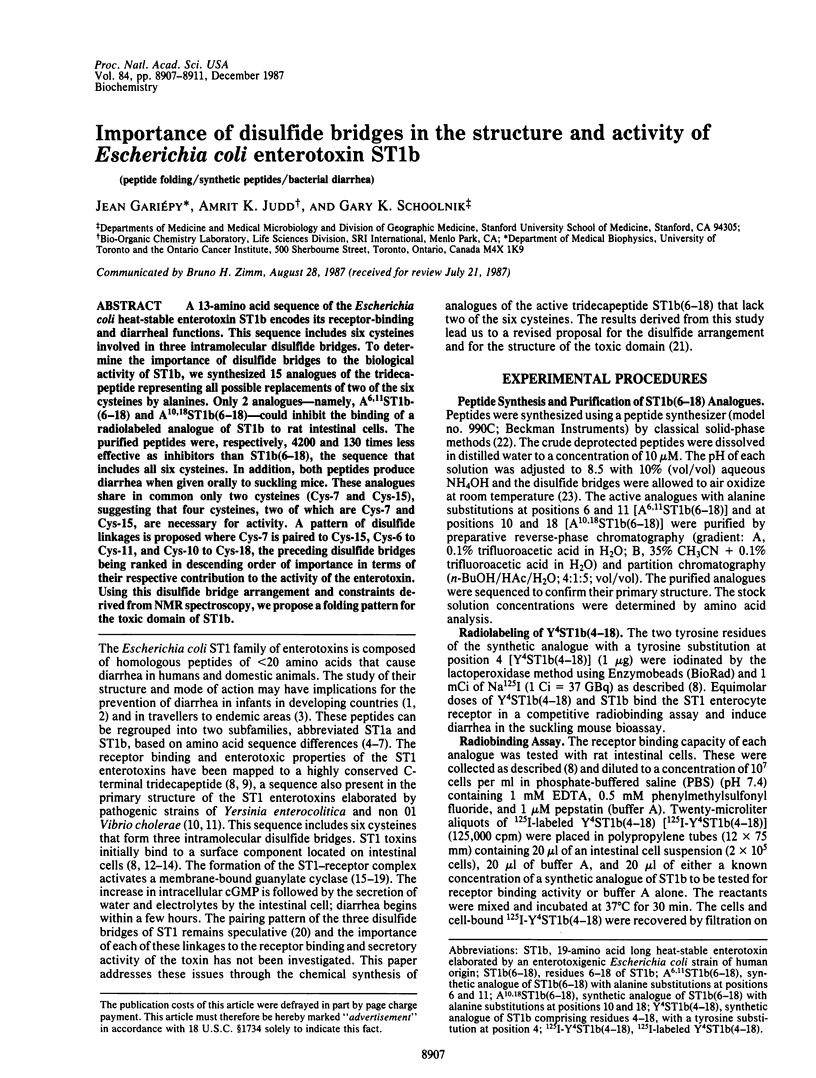
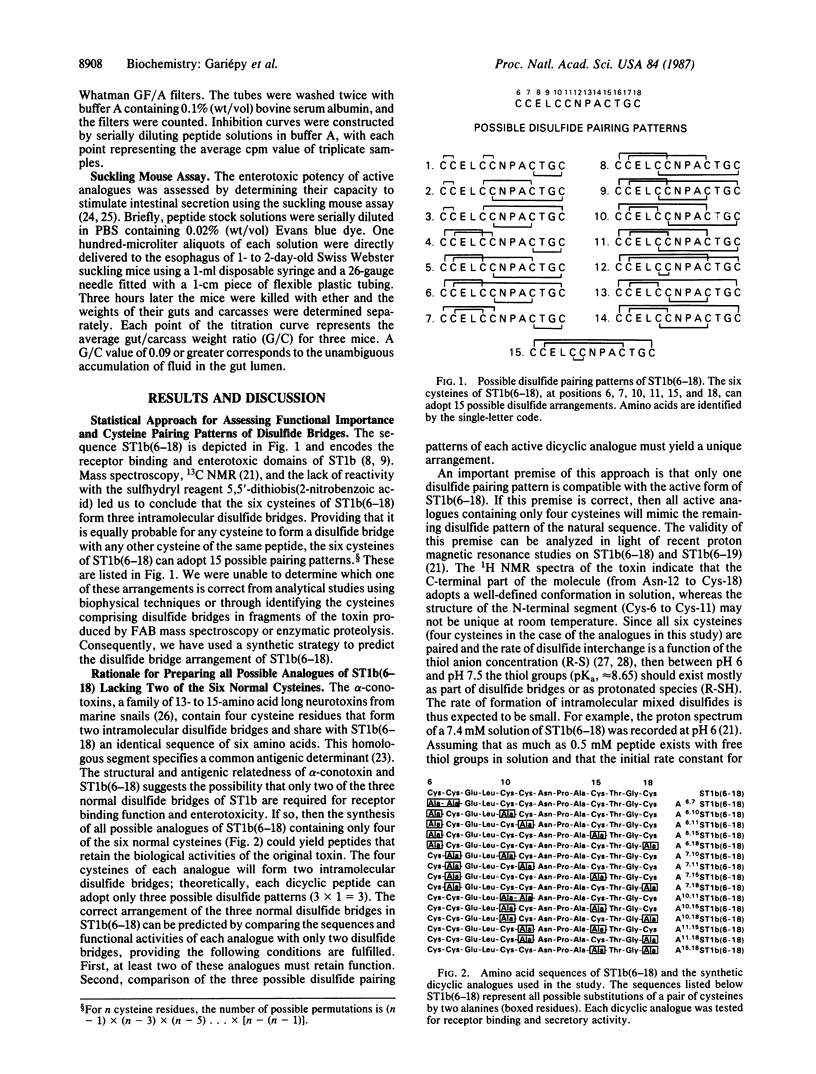
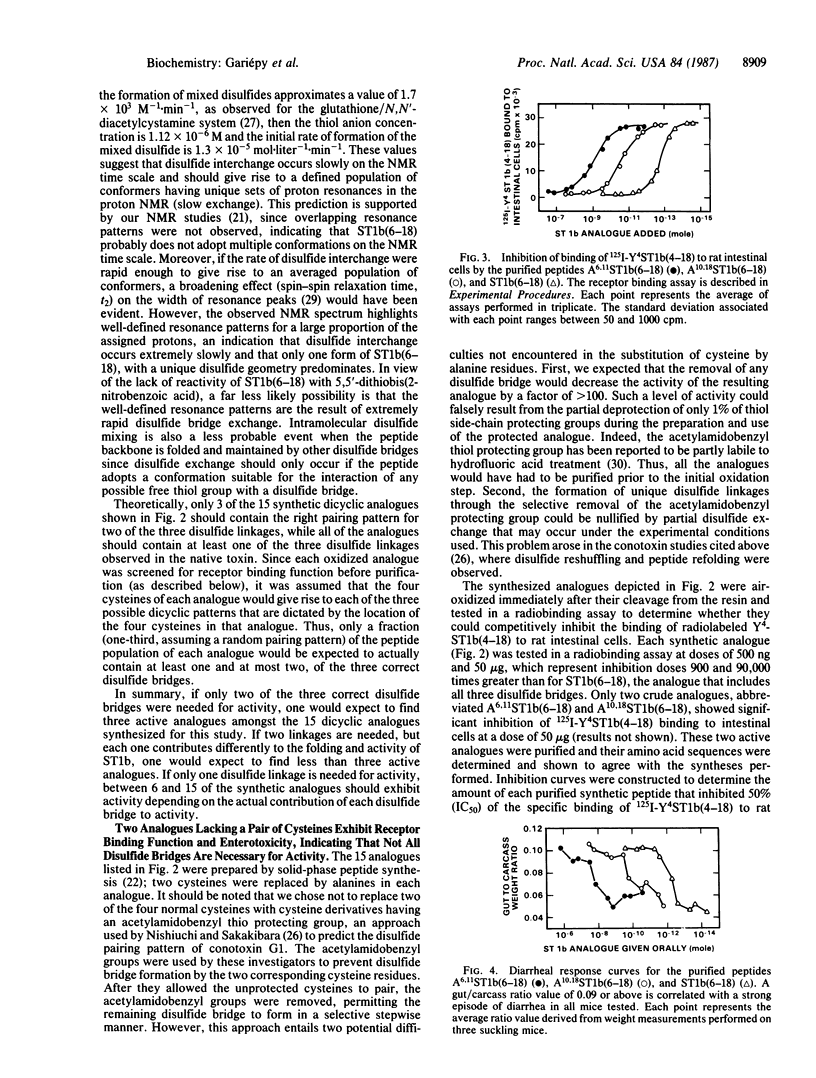
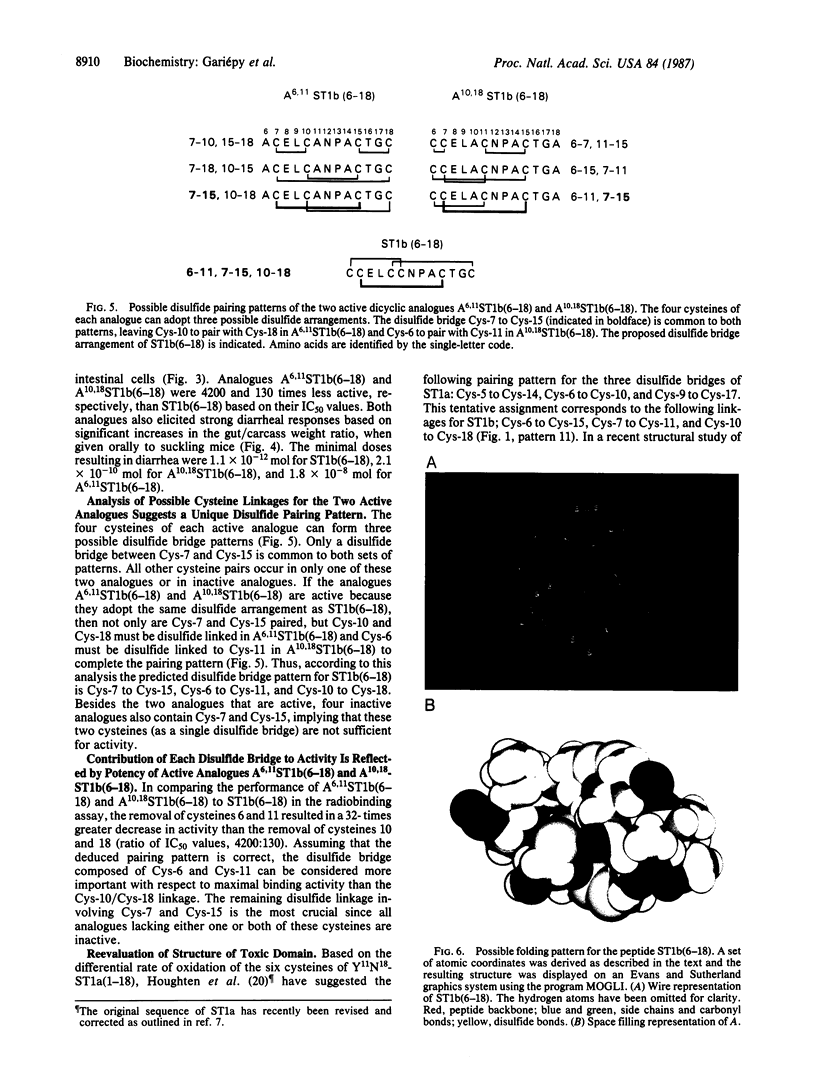
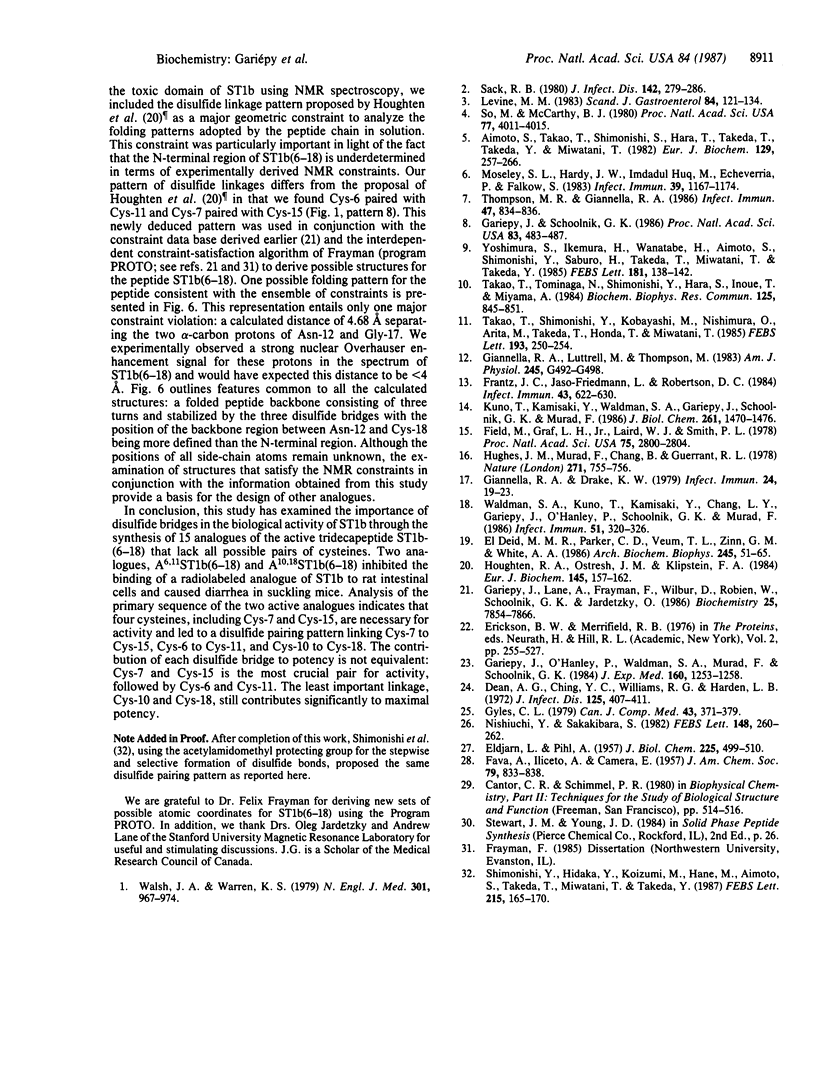
Images in this article
Selected References
These references are in PubMed. This may not be the complete list of references from this article.
- Aimoto S., Takao T., Shimonishi Y., Hara S., Takeda T., Takeda Y., Miwatani T. Amino-acid sequence of a heat-stable enterotoxin produced by human enterotoxigenic Escherichia coli. Eur J Biochem. 1982 Dec 15;129(2):257–263. doi: 10.1111/j.1432-1033.1982.tb07047.x. [DOI] [PubMed] [Google Scholar]
- Dean A. G., Ching Y. C., Williams R. G., Harden L. B. Test for Escherichia coli enterotoxin using infant mice: application in a study of diarrhea in children in Honolulu. J Infect Dis. 1972 Apr;125(4):407–411. doi: 10.1093/infdis/125.4.407. [DOI] [PubMed] [Google Scholar]
- ELDJARN L., PIHL A. On the mode of action of x-ray protective agents. II. Interaction between biologically important thiols and disulfides. J Biol Chem. 1957 Mar;225(1):499–510. [PubMed] [Google Scholar]
- ElDeib M. M., Parker C. D., Veum T. L., Zinn G. M., White A. A. Characterization of intestinal brush border guanylate cyclase activation by Escherichia coli heat-stable enterotoxin. Arch Biochem Biophys. 1986 Feb 15;245(1):51–65. doi: 10.1016/0003-9861(86)90189-x. [DOI] [PubMed] [Google Scholar]
- Field M., Graf L. H., Jr, Laird W. J., Smith P. L. Heat-stable enterotoxin of Escherichia coli: in vitro effects on guanylate cyclase activity, cyclic GMP concentration, and ion transport in small intestine. Proc Natl Acad Sci U S A. 1978 Jun;75(6):2800–2804. doi: 10.1073/pnas.75.6.2800. [DOI] [PMC free article] [PubMed] [Google Scholar]
- Frantz J. C., Jaso-Friedman L., Robertson D. C. Binding of Escherichia coli heat-stable enterotoxin to rat intestinal cells and brush border membranes. Infect Immun. 1984 Feb;43(2):622–630. doi: 10.1128/iai.43.2.622-630.1984. [DOI] [PMC free article] [PubMed] [Google Scholar]
- Gariepy J., O'Hanley P., Waldman S. A., Murad F., Schoolnik G. K. A common antigenic determinant found in two functionally unrelated toxins. J Exp Med. 1984 Oct 1;160(4):1253–1258. doi: 10.1084/jem.160.4.1253. [DOI] [PMC free article] [PubMed] [Google Scholar]
- Gariépy J., Lane A., Frayman F., Wilbur D., Robien W., Schoolnik G. K., Jardetzky O. Structure of the toxic domain of the Escherichia coli heat-stable enterotoxin ST I. Biochemistry. 1986 Dec 2;25(24):7854–7866. doi: 10.1021/bi00372a011. [DOI] [PubMed] [Google Scholar]
- Gariépy J., Schoolnik G. K. Design of a photoreactive analogue of the Escherichia coli heat-stable enterotoxin STIb: use in identifying its receptor on rat brush border membranes. Proc Natl Acad Sci U S A. 1986 Jan;83(2):483–487. doi: 10.1073/pnas.83.2.483. [DOI] [PMC free article] [PubMed] [Google Scholar]
- Giannella R. A., Drake K. W. Effect of purified Escherichia coli heat-stable enterotoxin on intestinal cyclic nucleotide metabolism and fluid secretion. Infect Immun. 1979 Apr;24(1):19–23. doi: 10.1128/iai.24.1.19-23.1979. [DOI] [PMC free article] [PubMed] [Google Scholar]
- Giannella R. A., Luttrell M., Thompson M. Binding of Escherichia coli heat-stable enterotoxin to receptors on rat intestinal cells. Am J Physiol. 1983 Oct;245(4):G492–G498. doi: 10.1152/ajpgi.1983.245.4.G492. [DOI] [PubMed] [Google Scholar]
- Gyles C. L. Limitations of the infant mouse test for Escherichia coli heat stable enterotoxin. Can J Comp Med. 1979 Oct;43(4):371–379. [PMC free article] [PubMed] [Google Scholar]
- Houghten R. A., Ostresh J. M., Klipstein F. A. Chemical synthesis of an octadecapeptide with the biological and immunological properties of human heat-stable Escherichia coli enterotoxin. Eur J Biochem. 1984 Nov 15;145(1):157–162. doi: 10.1111/j.1432-1033.1984.tb08535.x. [DOI] [PubMed] [Google Scholar]
- Hughes J. M., Murad F., Chang B., Guerrant R. L. Role of cyclic GMP in the action of heat-stable enterotoxin of Escherichia coli. Nature. 1978 Feb 23;271(5647):755–756. doi: 10.1038/271755a0. [DOI] [PubMed] [Google Scholar]
- Kuno T., Kamisaki Y., Waldman S. A., Gariepy J., Schoolnik G., Murad F. Characterization of the receptor for heat-stable enterotoxin from Escherichia coli in rat intestine. J Biol Chem. 1986 Jan 25;261(3):1470–1476. [PubMed] [Google Scholar]
- Levine M. M. Travellers' diarrhoea: prospects for successful immunoprophylaxis. Scand J Gastroenterol Suppl. 1983;84:121–134. [PubMed] [Google Scholar]
- Moseley S. L., Hardy J. W., Hug M. I., Echeverria P., Falkow S. Isolation and nucleotide sequence determination of a gene encoding a heat-stable enterotoxin of Escherichia coli. Infect Immun. 1983 Mar;39(3):1167–1174. doi: 10.1128/iai.39.3.1167-1174.1983. [DOI] [PMC free article] [PubMed] [Google Scholar]
- Nishiuchi Y., Sakakibara S. Primary and secondary structure of conotoxin GI, a neurotoxic tridecapeptide from a marine snail. FEBS Lett. 1982 Nov 8;148(2):260–262. doi: 10.1016/0014-5793(82)80820-x. [DOI] [PubMed] [Google Scholar]
- Sack R. B. Enterotoxigenic Escherichia coli: identification and characterization. J Infect Dis. 1980 Aug;142(2):279–286. doi: 10.1093/infdis/142.2.279. [DOI] [PubMed] [Google Scholar]
- Shimonishi Y., Hidaka Y., Koizumi M., Hane M., Aimoto S., Takeda T., Miwatani T., Takeda Y. Mode of disulfide bond formation of a heat-stable enterotoxin (STh) produced by a human strain of enterotoxigenic Escherichia coli. FEBS Lett. 1987 May 4;215(1):165–170. doi: 10.1016/0014-5793(87)80134-5. [DOI] [PubMed] [Google Scholar]
- So M., McCarthy B. J. Nucleotide sequence of the bacterial transposon Tn1681 encoding a heat-stable (ST) toxin and its identification in enterotoxigenic Escherichia coli strains. Proc Natl Acad Sci U S A. 1980 Jul;77(7):4011–4015. doi: 10.1073/pnas.77.7.4011. [DOI] [PMC free article] [PubMed] [Google Scholar]
- Takao T., Shimonishi Y., Kobayashi M., Nishimura O., Arita M., Takeda T., Honda T., Miwatani T. Amino acid sequence of heat-stable enterotoxin produced by Vibrio cholerae non-01. FEBS Lett. 1985 Dec 2;193(2):250–254. doi: 10.1016/0014-5793(85)80163-0. [DOI] [PubMed] [Google Scholar]
- Takao T., Tominaga N., Shimonishi Y., Hara S., Inoue T., Miyama A. Primary structure of heat-stable enterotoxin produced by Yersinia enterocolitica. Biochem Biophys Res Commun. 1984 Dec 28;125(3):845–851. doi: 10.1016/0006-291x(84)91360-3. [DOI] [PubMed] [Google Scholar]
- Thompson M. R., Giannella R. A. Revised amino acid sequence for a heat-stable enterotoxin produced by an Escherichia coli strain (18D) that is pathogenic for humans. Infect Immun. 1985 Mar;47(3):834–836. doi: 10.1128/iai.47.3.834-836.1985. [DOI] [PMC free article] [PubMed] [Google Scholar]
- Waldman S. A., Kuno T., Kamisaki Y., Chang L. Y., Gariepy J., O'Hanley P., Schoolnik G., Murad F. Intestinal receptor for heat-stable enterotoxin of Escherichia coli is tightly coupled to a novel form of particulate guanylate cyclase. Infect Immun. 1986 Jan;51(1):320–326. doi: 10.1128/iai.51.1.320-326.1986. [DOI] [PMC free article] [PubMed] [Google Scholar]
- Walsh J. A., Warren K. S. Selective primary health care: an interim strategy for disease control in developing countries. N Engl J Med. 1979 Nov 1;301(18):967–974. doi: 10.1056/NEJM197911013011804. [DOI] [PubMed] [Google Scholar]
- Yoshimura S., Ikemura H., Watanabe H., Aimoto S., Shimonishi Y., Hara S., Takeda T., Miwatani T., Takeda Y. Essential structure for full enterotoxigenic activity of heat-stable enterotoxin produced by enterotoxigenic Escherichia coli. FEBS Lett. 1985 Feb 11;181(1):138–142. doi: 10.1016/0014-5793(85)81129-7. [DOI] [PubMed] [Google Scholar]




